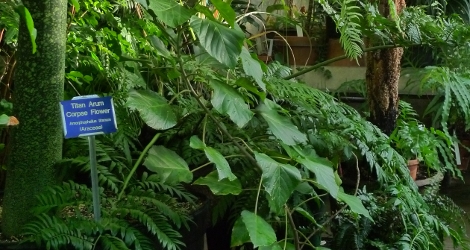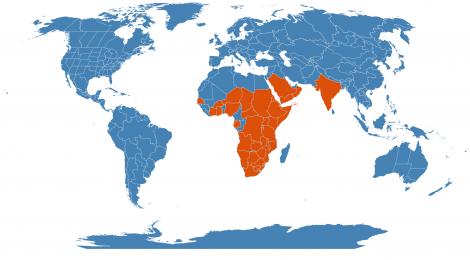Accession Data:
Asparagus africanus Lam.
- Common Name:
- Family: Asparagaceae Juss.
- Synonym(s): Our accession is NOT Asparagus africanus as labelled. Keeping the page here until we positively ID or elect to deaccession it.
- Description: 9 November 2018 - Our accession is NOT Asparagus africanus as labelled. Keeping the page here until we positively ID or elect to deaccession it.
- Uses:
As an African plant, it has been traditionally used in remedies for hair loss. The leaves are crushed and used to stimulate the scalp. When it is taken orally, it can be used to treat the presence of blood in urine. When it is made into a poultice, it can treat inflammation or guinea worm sores. In Sudan, the plant is a remedy for syphilis and used to flush the body of liquids.3- IMPORTANT NOTE: Plant Uses are for informational purposes only. EEB Greenhouses assume no responsibility for adverse effects from the use of any plants referred to on this site. Always seek advice from a professional before using any plant medicinally.
- USDA Zone: 9a-11
Accession Data:
- Accession # 198502392
- Source: Unknown
- Accession Date: 12-31-1985
- Bench: 1108 - AFR:West Bench SC
- Currently: active - healthy
- Qty: 3 confirmed on 02-26-2025
Classification:
- Division: Magnoliophyta
- Class: Liliopsida
- SubClass: monocots
- Order: Asparagales
- SubOrder:
- Family: Asparagaceae
- SubFamily: Asparagoideae
- Tribe:
- SubTribe:
Flowering Data:
This accession has been observed in bloom on:| Year | Jan | Feb | Mar | Apr | May | Jun | Jul | Aug | Sep | Oct | Nov | Dec | ||||||||||||||||||||||||||||||||||||||||
|---|---|---|---|---|---|---|---|---|---|---|---|---|---|---|---|---|---|---|---|---|---|---|---|---|---|---|---|---|---|---|---|---|---|---|---|---|---|---|---|---|---|---|---|---|---|---|---|---|---|---|---|---|
| 2025 | ||||||||||||||||||||||||||||||||||||||||||||||||||||
| 2024 | ||||||||||||||||||||||||||||||||||||||||||||||||||||
| 2023 | ||||||||||||||||||||||||||||||||||||||||||||||||||||
| 2022 | ||||||||||||||||||||||||||||||||||||||||||||||||||||
| 2021 | ||||||||||||||||||||||||||||||||||||||||||||||||||||
| 2020 | ||||||||||||||||||||||||||||||||||||||||||||||||||||
| 2019 | ||||||||||||||||||||||||||||||||||||||||||||||||||||
| 2018 | ||||||||||||||||||||||||||||||||||||||||||||||||||||
References (internal):
- EEB 3271 - Systematic Botany
- EEB 3203 - Developmental Plant Morphology
- Medicinal Plants - Traditional African Medicine
- Medicinal Plants - Integumentary System
- Medicinal Plants - Urinary System
- Medicinal Plants
- EEB Greenhouse Holdings native to: Benin / Burkina / Gambia, The / Ghana / Ivory Coast / Nigeria / Niger / Senegal / Togo / Burundi / Central African Republic / Equatorial Guinea / Gabon / Rwanda / Zaire / Chad / Djibouti / Eritrea / Ethiopia / Socotra / Somalia / Sudan / Kenya / Tanzania / Uganda / Angola / Malawi / Mozambique / Zambia / Zimbabwe / Botswana / Cape Provinces / Lesotho / Namibia / KwaZulu-Natal / Free State / Swaziland / Northern Provinces / Oman / Saudi Arabia / Yemen / India /
References (external):
- The Plant List (2013). Version 1.1. Last accessed on Monday, April 02, 2018.
- WCSP (2017). World Checklist of Selected Plant Families. Facilitated by the Royal Botanic Gardens, Kew. Last accessed on Monday, April 02, 2018.
- Iwu M., Maurice. Handbook of African Medicinal Plants. Boca Raton, Florida, CRC Press, 1993.
- Asparagus africanus at PlantzAfrica. Last accessed Thursday, 08 November, 2018.
data regenerated on Thu, 24 Apr 2025 15:27:15 -0400 [bcm v4.0]
Images:

Additional images for this accession:
Click on thumbnails to enlargeCurrent Accessions in the Asparagaceae
Subfamily Agavoideae
Subfamily Agavoideae
Tribe Agaveae
- Agave americana


- Agave americana 'Marginata'

- Agave attenuata

- Agave cf parryi
- Agave cf stricta
- Agave cf. titanota
- Agave guiengola W/C

- Agave murpheyi

- Agave nizandensis

- Agave parrasana

- Agave parryi

- Agave polianthiflora

- Agave schidigera

- Agave sisalana


- Agave tequilana


- Agave victoriae-reginae

- Agave victoriae-reginae

- Beschorneria septentrionalis


- Furcraea foetida

- Hosta sieboldiana


- Hosta tsushimensis W/C

- Manfreda maculosa

- Polianthes tuberosa

- Yucca glauca

Subfamily Agavoideae
Tribe Anemarrheneae
Subfamily Agavoideae
Tribe Anthericeae
Subfamily Asparagoideae
Subfamily Lomandroideae
Tribe Arthropodium group
Subfamily Lomandroideae
Tribe Cordylineae
Subfamily Lomandroideae
Tribe Lomandreae
Subfamily Nolinoideae
Tribe Convallarieae
- Aspidistra elatior


- Aspidistra grandiflora W/C

- Aspidistra tonkinensis W/C

- Reineckea carnea

- Tupistra kressii W/C


- Tupistra urceolata W/C


Subfamily Nolinoideae
Tribe Dracaeneae
- Dracaena aethiopica

- Dracaena angolensis

- Dracaena angolensis

- Dracaena aubryana

- Dracaena draco

- Dracaena masoniana

- Dracaena parva

- Dracaena pethera var. pulchra

- Dracaena reflexa

- Dracaena reflexa var. angustifolia

- Dracaena singularis
- Dracaena spathulata W/C

- Dracaena spathulata W/C

- Dracaena trifasciata

- Dracaena trifasciata

Subfamily Nolinoideae
Tribe Eriospermeae
Subfamily Nolinoideae
Tribe Nolineae
Subfamily Nolinoideae
Tribe Ophiopogoneae
- Liriope muscari 'Variegata'

- Ophiopogon jaburan Argenteo-marginatus

- Ophiopogon japonicus


- Peliosanthes macrostegia W/C

Subfamily Nolinoideae
Tribe Rusceae
Subfamily Scilloideae
Tribe Hyacintheae
- Camassia quamash

- Hyacinthinae: Leopoldia longipes

- Hyacinthinae: Scilla peruviana

- Massoniinae: Drimiopsis botryoides


- Massoniinae: Drimiopsis maculata


- Massoniinae: Eucomis bicolor


- Massoniinae: Eucomis vandermerwei W/C


- Massoniinae: Lachenalia aloides

- Massoniinae: Lachenalia bulbifera


- Massoniinae: Lachenalia cf. longituba W/C

- Massoniinae: Lachenalia ensifolia


- Massoniinae: Lachenalia rubida

- Massoniinae: Lachenalia unifolia W/C

- Massoniinae: Lachenalia viridiflora


- Massoniinae: Ledebouria socialis

- Massoniinae: Massonia depressa W/C


- Massoniinae: Massonia pygmaea


- Massoniinae: Veltheimia bracteata


Subfamily Scilloideae
Tribe Ornithogaleae
- Albuca bracteata W/C


- Albuca bracteata


- Albuca concordiana W/C

- Albuca setosa W/C

- Albuca spiralis W/C

- Albuca tortuosa

- Albuca virens W/C

- Ornithogalum adseptentrionesvergentulum

- Albuca concordiana W/C

- Ornithogalum graminifolium W/C

- Ornithogalum hispidulum W/C

- Ornithogalum sardienii W/C


- Ornithogalum thyrsoides


Subfamily Scilloideae
Tribe Urgineeae
- Bowiea volubilis


- Bowiea volubilis ssp. gariepensis


- Bowiea volubilis ssp. volubilis

- Drimia haworthioides

- Drimia intricata

- Drimia platyphylla W/C


- Drimia sp. W/C
- Drimia uniflora W/C


 = indicates flowering in past 14 days
= indicates flowering in past 14 days
 = images available for this accession
= images available for this accession
 = map available for this accession
= map available for this accession
 = accession added within past 90 days
= accession added within past 90 days

